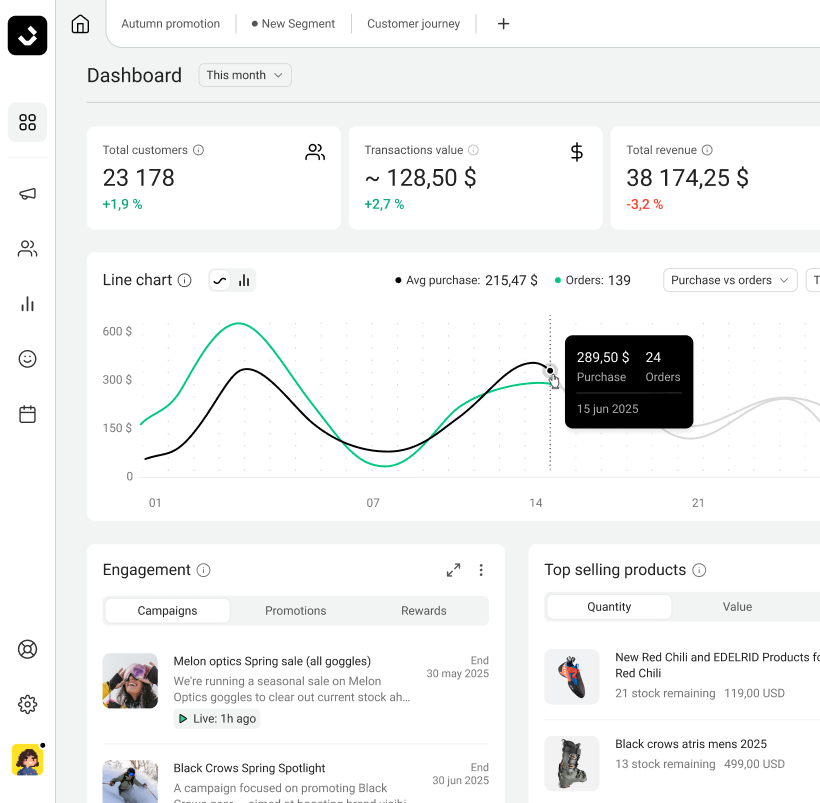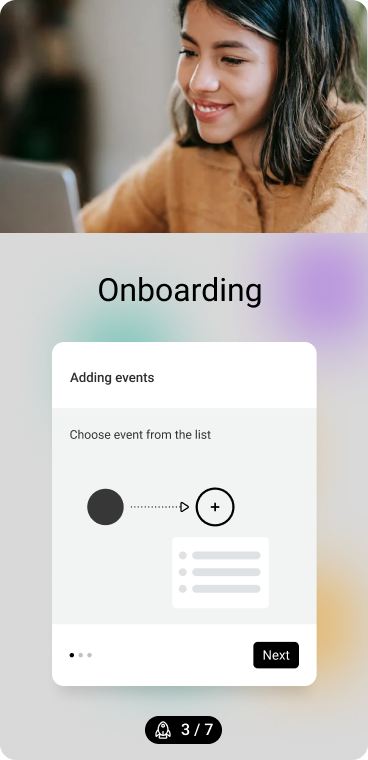Comarch Loyalty Management
CLM – Comarch Loyalty Management, is a comprehensive platform for managing customer loyalty.
Growth stage
Enterprise
Company size
6 000+
Industry
Customer Engagement Technology
Market
Global
Product
Web application
Comarch Loyalty Management
Growth stage
Enterprise
Company size
6 000+
Industry
Customer Engagement Technology
Market
Global
Product
Web application
About project
A loyalty system designed to keep customers coming back – simple to use, smart under the hood, and built for scale.
My role
I was part of the core team behind CLM6, contributing to the overall design and user experience of the platform.
Throughout the project, I worked closely with project managers and analysts with deep expertise in the previous version (v5). Their insights, combined with feedback from clients, helped me understand key pain points, map critical flows, and reimagine the experience from the ground up.
Problem
Interface of the CLM and UX gradually became outdated, falling behind modern design standards and user expectations.
The system suffered from an outdated UI, low accessibility, and a high level of complexity. New users often had to go through long and demanding training sessions just to perform basic tasks. This complexity created a high barrier to entry and made it difficult to adopt the tool in smaller organizations or teams without technical support.
Eventually, it became clear that a complete redesign was necessary — not just a visual refresh, but a structural rethinking. The goal was to build a new version of CLM that would align with current UX/UI standards, address real user needs, and be offered as a scalable cloud-based SaaS solution.
Goal
The goal was to create a simplified, and accessible version of CLM that eliminates friction and reduces the learning curve.
We wanted to build a tool that is powerful but intuitive — where users can manage campaigns, promotions, and customer segments without needing advanced training.
To support this, we integrated AI-powered features such as smart predictions, natural language processing (NLP), and machine learning. These enhancements allow the system to proactively suggest campaign timings, analyze performance, detect anomalies, and recommend actions based on user behavior and business data.
Design process
Discovery
During discovery we took a deep dive into CLM5 current experience.
Desk research • Audit UX / UI Competitors Analysis • Hypothesis
Define
In the define phase, we organized the findings from discovery into clear problem statements and mapped out key pain points.
Research insight syntesis • Issue table • Mind map
Develop
In the define phase, we organized the findings from discovery into clear problem statements. Insights from the card sorting sessions helped us identify patterns in user expectations, which led to a redesigned navigation structure and a new, more intuitive information architecture.
Concepts / prototypes • Customer journey • Card sorting • Reports • Research synthesis
Deliver
In this final stage, we wrapped up research findings into clear reports and added refined UI components to the design system.
Data synthesis • Documentation • Design system
Card sorting
While analyzing the previous version of the CLM platform, we knew we had to start by rethinking the information architecture.
To guide this process, Researchers conducted an open card sorting study with 12 participants to understand how users naturally group and prioritize key features and content.
Each participant—coming from different roles and industries—had unique needs and expectations, which translated into varied ideas of navigation structures and dashboard content. These insights highlighted the importance of flexibility.
From the card sorting sessions, a few clear patterns emerged. Participants emphasized the need for customizable navigation, the ability to modify dashboard layouts and widgets, and to create separate workspaces tailored to individual projects, as each project typically required a different structure and set of tools.
Additionally, due to the complexity of the CLM system, desktop or laptop devices were strongly preferred for daily use, while the mobile version was generally seen as useful in a view-only capacity, meant for quick access rather than deep interaction.
As a result, we designed a solution that enables users to customize their navigation, choose from industry-specific workspaces, and create tailored dashboards using a library of pre-configured widgets. The research helped us move from a one-size-fits-all approach to a modular, adaptive system that scales with user context.
Dashboard
The redesigned CLM dashboard serves as a central place where all key data points converge.
From campaign performance and promotion analytics to customer engagement metrics.
One of its core elements is the real-time stream, which provides live updates about campaign progress. If a campaign underperforms or fails to meet its goals, users are notified immediately, allowing for quick reaction and optimization.
The dashboard is fully customizable: users can add or remove widgets, integrate external data sources, and tailor the view to fit their specific needs. Additionally, multiple workspaces can be created to support various teams, campaigns, or business goals — offering a flexible, user-centric experience designed for scale and efficiency.


Customer journey
Customer journey to trigger campaign in right time.
The builder is intuitive and flexible — marketers can define triggers, set conditions, and assign outcomes without writing a single line of code. This allows teams to respond to user behavior dynamically and deliver meaningful experiences at scale.
Each journey can be linked directly to specific promotions, campaigns, or user segments, making it easy to automate personalized communication and actions across the entire loyalty and e-commerce ecosystem.


Users can create journeys from scratch using predefined events, or start with ready-made templates tailored to typical marketing scenarios.
Audience
Strategic audience builder & targeting logic  automated.
automated.
Users can build target groups using a visual Rule Builder, where set simple rules with “and/or” logic – like “users who bought skis OR visited the climbing gear page.”
To make things even easier, there’s NLP support so you can type rules in plain language and the system turns them into logic automatically.
There are also ready-made templates and saved audiences you can reuse, which speeds up creating new campaigns and keeps everything consistent.
Segments
Create and compare segments.
Segments can be selected from existing templates or created from scratch using the Rule Builder. This flexibility makes it easy to explore key behavioral and demographic differences, helping teams tailor campaigns more effectively.
The dashboard includes key metrics such as the number of users in each segment, trend indicators, and visualizations like Venn diagrams for segment overlap and line charts showing changes over time. This is especially useful for strategic planning, A/B testing, or evaluating campaign performance across different target groups.
The segment comparison allows users to analyze and compare up to five custom or predefined customer segments side by side.
Summary and conclusions
CLM was a long-term collaboration aimed at redesigning one of Comarch’s flagship products — a loyalty management platform used by enterprise clients around the world.
Design & UX/UI Strategy
- Developed a complete user flow for an enterprise-grade loyalty platform.
- Designed a modular UI component system based on atomic design principles.
- Collaborated closely with Comarch’s product and development teams to implement the design system.
- Validated and optimized information architecture (IA) for various user types (marketer, sales rep, analyst).
Implementation & Business Impact
- Unified interfaces across multiple Comarch loyalty products.
- Helped reposition the product as a modern, competitive loyalty solution for enterprise clients.
- Unified UI and UX across the platform improved clarity and reduced onboarding time for new users.
- The design system enabled faster iteration and rollout of new modules, streamlining product development.
- A more modular architecture allowed better customization for clients in different industries, making the product more competitive in the loyalty solutions market.
Team & Process
- Worked within an interdisciplinary team (PM, Product Owner, Dev, QA)
- Maintained close communication with stakeholders (marketing, sales, IT).
Benefits for end users
- Intuitive UI enables campaign setup without IT support.
- Loyalty campaigns can now be personalized even by less advanced users.
- Intuitive navigation and improved screen layouts reduced the time needed for daily operations.
- Users gained more control over their loyalty campaigns and a better understanding of results thanks to a clearer data structure.
What we learned?
- Even complex, multi-layered systems can be simplified — the key is deep user understanding and clear alignment on priorities across teams.
- Close collaboration with product, design, and analytics teams helps surface and solve issues rooted in day-to-day product usage.
- A well-structured design system accelerates development and ensures consistency across large-scale platforms.